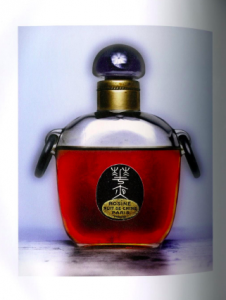The “China Through the Looking Glass” exhibition in the Metropolitan Museum of New York aims to capture Chinese aspects of art, fashion, and culture and appreciate it. It’s goal overall is to sell the idea that Western and Eastern art and fashion influence each other, but I argue that it is mostly the West orientalizing the East, specifically exotifying the most tangible qualities. Many of the art pieces are misrepresentations of Chinese culture and do not indicate appreciation for the real meanings behind the art, but just its unique qualities. This perfume bottle from the exhibit is an object that has aspects to contribute to the consumer orientalizing aspects of the West influencing the East. The exhibit titled its section “enigmatic spaces,” to contribute to the mystifying the Chinese culture, rather than attempting to understand it. The perfume bottle in this exhibit exemplifies the orientalizing of Chinese people and culture from the Western perspective from its name “Nuit de Chine” and fake Chinese writing, among other details.

Les Parfums de Rosine (French 1911). “Nuit de Chine” perfume flacon.
Perfume Bottle
The photo shows an artistic display of a perfume bottle and the enigmatic space it takes up. The bottle is selling a scent, with red and purple accents. It is a memorable, unique shape. From this display, we can infer that the bottle is representing the repackaging of Chinese culture. Somehow, the brand of perfume is able to capture the “scent of China” and sell it. The Eastern manufactorers are able to produce and profit from the incorrect assumptions made from using a “Chinese” product. The makers of this perfume chose the colors red and purple, which symbolize exotic mystery, and relates China to this type of “other.” The perfume bottle shape and decorations allow one to exotify the Chinese culture incorrectly represented in this object.
“Nuit de Chine”
The product is called “Nuit de Chine,” which means “night in China” in French. The perfume bottle is from France, which only makes sense why the perfume’s name is in French. However, one must consider the meaning that the product somehow embodies the scent of a night in China. The perfume orientalizes the China lifestyle and culture, acting as if it is something one can acquire and wear. Westerners who are unfamiliar with Chinese culture may think the perfume is an accurate depiction of China, which diminishes the country’s value into a commodity. The Western perspective on this “Chinese” product and scent does not appreciate but devalues the Chinese culture.
Fake Chinese Writing
In addition to the title of the product, the perfume has some sort of characters on the bottle’s label. It is not distinctively Chinese, but it is the largest part of writing on the product. Due to the fact that the writing is not real Chinese, it is a huge indication of the lack of knowledge and respect for the Chinese culture in this product. The Western creators of the perfume bottle did not care to represent China in a correct way, but chose to create some kind of incorrect writing for the look of the product. Not only was fake Chinese writing incredibly disrespectful, it also allows the consumer to further orientalize Chinese culture by misrepresenting it. The consumer could ignorantly claim to know and understand Chinese culture, all because of the commodification of a fake representation of culture that the French company chose to portray.
Overall, the representation of China and its people’s culture is belittling and disrespectful. Western influences turned meaningful aspects of China into an orientalized commodity that could easily be misinterpreted. Rather than appreciating the true essence of Chinese culture, the French makers of “Nuit de Chine” essentialized race into a mysterious, exotic scent that could be misinterpreted in many ways.
you have made a number of critical statements and supported with visual evidence. further tie the statement and evidence close and in detail. For the question of bottle form, for instance, how does the bottle reflect Orientalization?
